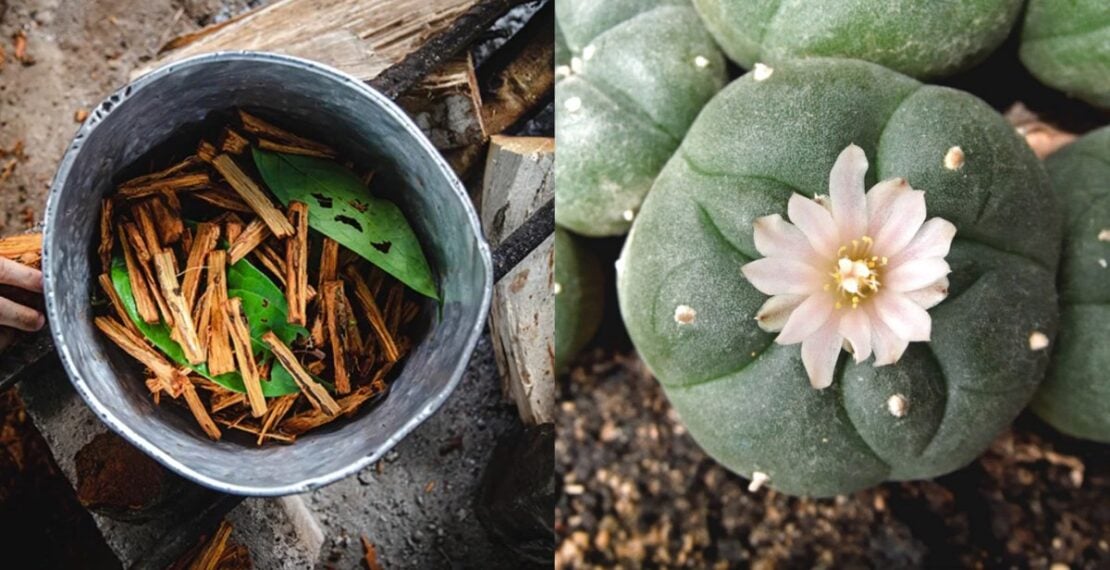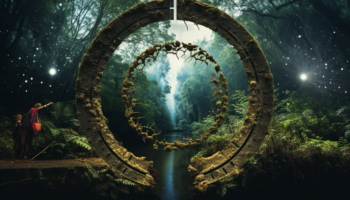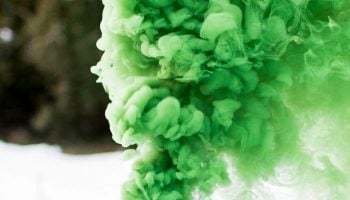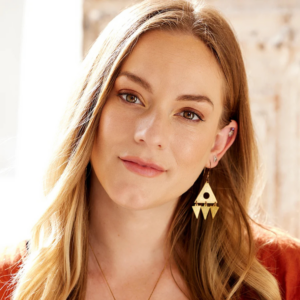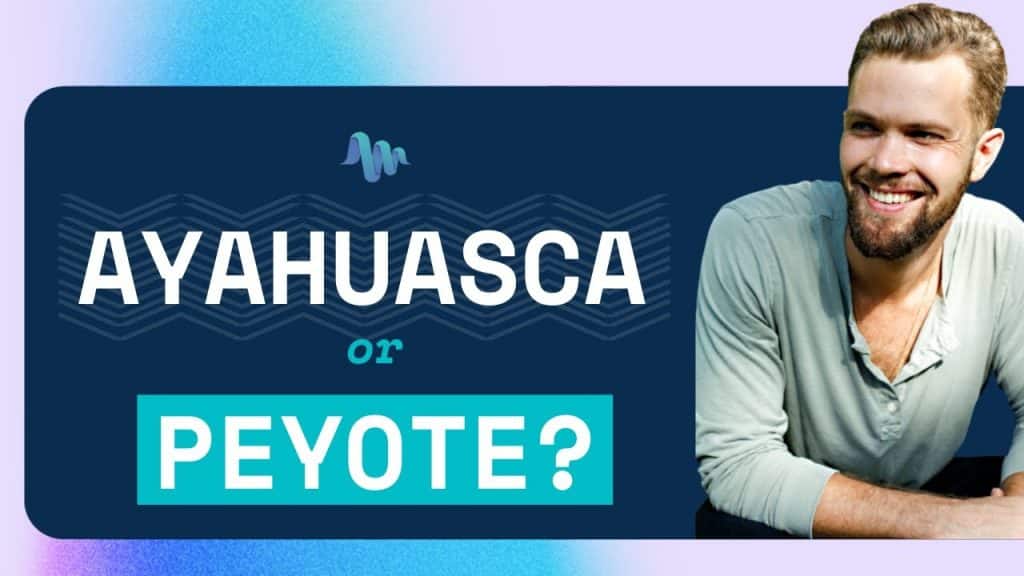
Disclaimer: Ayahuasca and Peyote are potentially illegal substances, and we do not encourage or condone the use of these substances where it is against the law. However, we accept that illegal drug use occurs and believe that offering responsible harm reduction information is imperative to keeping people safe. Therefore, this guide is designed to ensure the safety of those who decide to use the substance. We do not encourage using this drug outside of a legal or traditional context.
Disclosure: This article contains offers and affiliate links. Third Wave receives a small percentage of the product price if you purchase through affiliate links. Read our ethics and affiliates policy here.
Ayahuasca and peyote are plant medicines with powerful psychoactive effects. Both have been used recreationally and spiritually in various cultures and traditions. They carry similarities, such as enhancing transpersonal and spiritual experiences, but differ in many other features.
Peyote is known as the “grandfather” plant medicine due to its active, cerebral, clear, present, and more masculine psychedelic experience. The cactus is calmer and more manageable than wild “grandmother” ayahuasca.
Let’s dive into how these two plants differ in effects, ingredients, and personal experiences. If you want to learn more about their characteristics, you can watch the above video and learn about ayahuasca and peyote.
Ayahuasca and Peyote
Ayahuasca
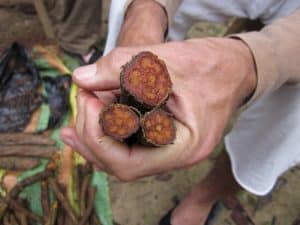
Ingestion of DMT does not deliver its psychoactive effects to the brain because our stomach has monoamine oxidase enzymes that rapidly break down DMT when ingested. B.caapi bark consists of beta-carboline monoamine oxidase inhibitors (MAOIs), which prevent DMT from being degraded by our digestive system. The DMT molecule can now reach the brain and act on its serotonin receptors.
Ayahuasca has a long lineage and traditional use, specifically by mestizo people and indigenous peoples living in Amazon, Peru, Brazil, Colombia, and Ecuador. In addition, it has been used in Brazil by such religions as the Santo Daime church. Their religious ceremonies, called trabalhos, include drinking the brew, purging, praying, dancing, and singing icaros, traditional magic songs.
Ayahuasca ceremonies involve groups of people gathering in a circle in darkness and are often facilitated by an elder healer called an ayahuasquero. The ritual guide, also known as the curandero, usually has years of practice and training with the plant. There are specific diet instructions, what’s called la dieta. two weeks before the ayahuasca experience, mainly to purify the body and prepare for the experience.
The diet includes the abolition of fried, fermented, or aged foods, canned or packaged products, protein- or yeast-based extracts or supplements, dairy products, overripe fruits, processed sweets, refined sugar, and salt. Another reason for the diet is to eliminate tyramine-rich foods, which interact negatively with MAOIs. Purging is a primary spiritual feature of the ceremony and plant healing, since it cleanses the body and mind.
Ayahuasca takes four to six years to reach maturity. However, the plant’s sustainability is still a concern due to increasing demand and plant-medicine tourism.
Read our Ultimate Ayahuasca Guide to learn more about this powerful psychedelic plant.
Peyote
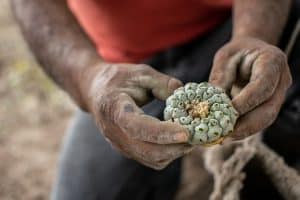
Peyote is traditionally used by Native American and pre-Columbian indigenous communities such as the Tonkawa or Mescalero tribes. Later, other cultures, such as the Chichimeca and Tarahumara (Rarámuri), Cora (Náayarite), and Huichol (Wixáritari), adopted peyote in their traditions.
Ritualization and community are important elements of peyote ceremonies. Tribes have used the cactus to understand the “self” better and connect with the community. Spiritual practices with peyote in these traditions often focus on decision-making, accepting grief, personal growth, and the well-being of individuals. Peyote is believed to restore the balance between the physical, emotional, and spiritual realms, initiating a sense of compassion and gratitude. In traditional use, prayer has an important role. The “medicine man” or “road man” leads the ceremony while drumming, praying, dancing, and singing. Peyote buttons (from the top of the cactus) are often chewed to release the active alkaloid that causes psychoactive effects, but the cactus can also be served as a tea.
Peyote matures slowly and has a narrow range in which it grows. It could take up to 30 years to grow large enough to be used. Therefore, the plant is currently an endangered species. Overharvesting peyote might cause its extinction, a significant threat to the communities who use it. It might be more suitable to work with the alternatives, such as the San Pedro cactus, the so-called Huachuma. San Pedro, another mescaline-containing cactus, is relatively abundant and grows rapidly everywhere. Learn more about San Pedro and the effects of mescaline on the cactus.
Please note that the Native American Church considers the use of peyote outside of its ritual contexts to be illegitimate. This issue is exacerbated by the cactus’s rarity and endangered classification. The Third Wave strongly suggests that those outside the Church forgo the use of peyote in favor of mescaline derived from the San Pedro cactus.
See our Peyote Guide and learn more about the psychedelic cacti.
Five Differences Between Ayahuasca and Peyote
- Ayahuasca is native to the Amazonian culture, and peyote is from northern Mexico and Southwest US.
- DMT is the primary active ingredient of ayahuasca, and mescaline is the main psychedelic compound of peyote.
- Peyote is considered masculine, and ayahuasca is a feminine plant medicine.
- Peyote experience is more subtle and gentle, and ayahuasca is more powerful, dream-like, and visual.
- Peyote experiences last around 12 hours, while ayahuasca lasts four to six hours.
How Is the Psychedelic Experience with Ayahuasca and Peyote?
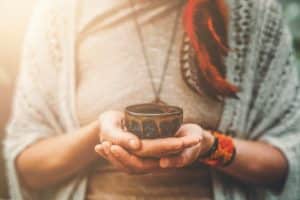
During the trip, people usually prefer to lie down or sit since it is relatively difficult to move or speak. Ayahuasca initiates altered states of consciousness, transpersonal experiences, and visual hallucinations and leads to increased empathy and self-awareness in users. In addition, the plant often brings back old memories and past traumas, which creates a great healing potential.
Peyote trips often last more than 12 hours, and the ceremonies occur overnight. People describe the psychoactive properties of peyote as increased tactile and auditory sensations followed by visual hallucinations and distortion of time and space.
Peyote experience often leads to the ego death of an individual and creates powerful spiritual insights and self-realization moments. The experience with peyote depends on the individual’s mindset, the environment in which the drug is taken, dosage, and the form of mescaline. Potency can differ in peyote buttons, dried powder, or peyote tea. Effects of peyote are often reported as leading to depersonalization, disordered thought patterns, altered sense of time and space, and strong visual alterations.
Side Effects of Ayahuasca and Peyote
Side effects of both plants can be physically and psychologically intense. To avoid potential bad trips, it is imperative to work with them in a safe setting and with a practitioner or shaman. Ayahuasca’s potential side effects include:
- Nausea
- Tingling
- Dizziness
- Increased heart rate
- Increased blood pressure
- Decreased body temperature
- Shivering
- Sweating
- Purging/vomiting
Peyote’s potential side effects:
- Nausea
- Increased heartbeat
- Increased libido
- Increased blood pressure
- Contracted muscles
- Visual distortions
Anecdotal Reports on Ayahuasca
A qualitative study in 2021 investigated the impact of ayahuasca, interviewing 41 Western participants. One participant stated:
What she [ayahuasca] took me into was a very big trauma, and I re-experienced it. It was a terrifying time, but I recognized that she doesn’t allow you to dissociate. You relive the experience without the dissociation, which means that you have to deal with it in a different way than you did at the time. So, it took the terror out of it because I couldn’t escape it.
Another study looked for the therapeutic effects of ayahuasca in treating substance abuse. A participant explained:
Drug addiction is a process of lying to oneself, and ayahuasca is a truth medicine … what ayahuasca does is … unmask how the addict has accommodated the illness … . One can’t lie to oneself on ayahuasca. It will force you to see what you always ignore, and that is extremely disturbing … this becomes an opportunity for change … . The awareness of how the addict is deceiving himself and how lying to oneself is precisely how one gets addicted in the first place. This can be a dramatic shift in awareness of self that can be quite painful to endure, but with greater benefit … . I don’t know a more effective way to get people to confront their true selves. None of the Western medicines or methods can do this as ayahuasca does.
A psychonaut (psychedelic explorer) who recreationally experienced ayahuasca describes the benefits:
Ayahuasca, with a Shaman, helped me kick alcohol, smoking, casual sex, and a list of other self-destructive behaviors. Full experience.
Anecdotal Reports on Peyote
The use of peyote is not as common as the other psychedelic plants. However, there are still some discussions and sharing on online forums. We selected some peyote experiences that shed light on the plant’s unique power:
Up to this date, that is the best experience I have ever encountered […]. I highly recommend the spiritual, medicinal, or religious use of peyote to anyone seeking enlightenment. – Full experience.
I feel like a new person; I feel good alive and get this; days later, I got what I asked the peyote to help me get. The peyote told me it would be four days, and I got exactly four days later…what a good blessing.- Full experience.
This was my first time with peyote, but it has already become my favorite psychedelic, and I’ve tried many of them. As many have noted, peyote, and probably mescaline in general, is a drug which guides its user to heal emotional problems efficiently. – Full experience.
Another psychonaut indicates:
I had a similar experience with “Grandfather.” I felt connected to the land I was on. Felt truly at peace. But it was hard to retain the feelings and knowledge afterward. As well as trying to apply them to the practical world. Sometimes we don’t get what we want, though we get what we need. Love the experience….”good” or “bad”….and then leave it in the past.
Research on the Therapeutic Use of Ayahuasca and Peyote
There has been growing scientific interest in both ayahuasca’s and peyote’s potential therapeutic applications in the last decade. Beyond ayahuasca’s possible use for addiction, the plant also appears to have antidepressant effects that help with TRD (treatment-resistant depression) and also causes significant long-term improvements in mental health.
Peyote has been used for medical conditions such as toothaches, rheumatism, asthma, and even cold symptoms. In addition, it is believed to cure physiological problems such as animal bites, skin diseases, and chronic pain. Moreover, a study in 1974 proposed the use of peyote for alcoholism among American Indians. Contemporary research supported the peyote’s potential benefits for therapeutic purposes, a recent study revealed improvements in mood, anxiety, drug abuse, and lasting, positive life changes after the naturalistic use of mescaline.
Further, this study looked for the neuropsychological effects of long-term peyote use in native Americans compared to drug abusers. In this comparison, the peyote group showed no significant deficiency on memory and attention measurements whereas the alcoholic group showed some neuropsychological deficits.
How To Use Ayahuasca or Peyote for Healing
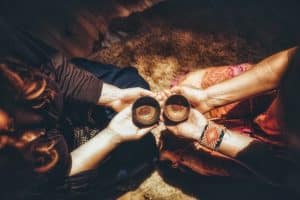
The globalization of ayahuasca has led to its cross-cultural use in the Amazon and other parts of the world. Various retreat centers offer transnational healing work with medicine. If you want to work with this plant medicine, see our directory to find ayahuasca retreat centers with experienced practitioners that align with your purpose.
Mescaline, the active ingredient of peyote, is an illegal substance in the UK, Canada, and Europe. In the United States, mescaline is a controlled Schedule I substance under the United Nations 1971 Convention on Psychotropic Substances. Read more about the legality of peyote.
However, the traditional use of peyote is exempted from this law. The members of the Native American Church (NAC) can still use mescaline and peyote in their religious and cultural rituals, and the community both uses and protects the plant.
Check our directory to find legal Peyote retreats worldwide.
Which Hallucinogenic Plant Is Right for Me?
Peyote and ayahuasca are powerful plant medicines that offer deep transformational and spiritual experiences. You can figure out which plant is better for you in relation to your intentions for and expectations from a psychedelic trip. Intentions can look like healing from unresolved traumas, strengthening relationships, or simply being curious about the experience. Choosing a suitable retreat to meet your expectations is essential.
Consider working with peyote if you want a more manageable, social, and pleasant trip. Ayahuasca might be more suitable for your purpose if you seek something more profound, spiritual, and penetrating.
Final Thoughts
Whether you are intrigued by the introspective ayahuasca experience or want to experience the more delicate grandfather peyote, you should be cautious of your source and who you sit with during the psychedelic experience. If you work with these plant medicines, be mindful about choosing an experienced practitioner you trust, preferably someone with a lot of experience, education, and knowledge of psychedelic plants.
Check out Third Wave’s Psychedelic Directory to discover all Ayahuasca or Peyote retreats with knowledgeable practitioners worldwide.
References
Albaugh, B. J., & Anderson, P. O. (1974). Peyote in the treatment of alcoholism among American Indians. The American journal of psychiatry, 131(11), 1247–1250. https://doi.org/10.1176/ajp.131.11.1247
Agin-Liebes, G., Haas, T. F., Lancelotta, R., Uthaug, M. V., Ramaekers, J. G., & Davis, A. K. (2021). Naturalistic use of mescaline is associated with self-reported psychiatric improvements and enduring positive life changes. ACS Pharmacology & Translational Science, 4(2), 543-552. https://doi.org/10.1021/acsptsci.1c00018
Erowid (2010, Jan 7). Peyote – Effects. Retrieved from https://erowid.org/plants/peyote/peyote_effects.shtml
Faria M. (2021). “Plants of the Gods” and their hallucinogenic powers in neuropharmacology — A review of two books. Surgical Neurology International, 12, 343. https://doi.org/10.25259/SNI_560_2021
Jan G. Bruhn, & Holmstedt, B. (1974). Early Peyote Research an Interdisciplinary Study. Economic Botany, 28(4), 353–390. http://www.jstor.org/stable/4253531
Lophophora williamsii: Peyote. (2006). Medicinal Properties. Retrieved from http://bioweb.uwlax.edu/bio203/2011/toellner_kayl/Medical.htm.
Olive, M. F., & Triggle, D. J. (2007). Peyote and mescaline. Infobase Publishing.
Palhano-Fontes, F., Barreto, D., Onias, H., Andrade, K. C., Novaes, M. M., Pessoa, J. A., Mota-Rolim, S. A., Osório, F. L., Sanches, R., Dos Santos, R. G., Tófoli, L. F., de Oliveira Silveira, G., Yonamine, M., Riba, J., Santos, F. R., Silva-Junior, A. A., Alchieri, J. C., Galvão-Coelho, N. L., Lobão-Soares, B., Hallak, J. E. C., … Araújo, D. B. (2019). Rapid antidepressant effects of the psychedelic ayahuasca in treatment-resistant depression: a randomized placebo-controlled trial. Psychological medicine, 49(4), 655–663. https://doi.org/10.1017/S0033291718001356
Peter N. Jones (2005) The American Indian Church and its sacramental use of peyote: A review for professionals in the mental-health arena, Mental Health, Religion & Culture, 8:4, 277-290, DOI: 10.1080/13674670412331304348
Prince, M. A., O’Donnell, M. B., Stanley, L. R., & Swaim, R. C. (2019). Examination of Recreational and Spiritual Peyote Use Among American Indian Youth. Journal of studies on alcohol and drugs, 80(3), 366–370. https://doi.org/10.15288/jsad.2019.80.366
Riba, J., Valle, M., Urbano, G., Yritia, M., Morte, A., & Barbanoj, M. J. (2003). Human pharmacology of ayahuasca: subjective and cardiovascular effects, monoamine metabolite excretion, and pharmacokinetics. The Journal of pharmacology and experimental therapeutics, 306(1), 73–8givesi.org/10.1124/jpet.103.049882
Schultes, R. E., Hofmann, A., Rätsch, C. (2001). Plants of the Gods: Their Sacred, Healing, and Hallucinogenic Powers. Rochester, VT: Healing Arts Press.
Tupper, K. W. (2009). Ayahuasca healing beyond the Amazon: The globalization of a traditional indigenous entheogenic practice. Global Networks, 9(1), 117-136. https://doi.org/10.1111/j.1471-0374.2009.00245.x
The Ayahuasca Phenomenon (2014, Nov 20)- MAPS. Retrieved from https://maps.org/2014/11/20/the-ayahuasca-phenomenon/
Thomas, G., Lucas, P., Capler, N. R., Tupper, K. W., & Martin, G. (2013). Ayahuasca-assisted therapy for addiction: results from a preliminary observational study in Canada. Current drug abuse reviews, 6(1), 30–42. https://doi.org/10.2174/15733998113099990003
Uthaug, M. V., van Oorsouw, K., Kuypers, K. P. C., van Boxtel, M., Broers, N. J., Mason, N. L., Toennes, S. W., Riba, J., & Rathe maekers, J. G. (2018). Sub-acute and long-term effects of ayahuasca on effect and cognitive thinking style and their association with ego dissolution. Psychopharmacology, 235(10), 2979–2989. https://doi.org/10.1007/s00213-018-4988-3
Zamberlan, F., Sanz, C., Martínez Vivot, R., Pallavicini, C., Erowid, F., Erowid, E., & Tagliazucchi, E. (2018). The varieties of the psychedelic experience: a preliminary study of the association between the reported subjective effects and the binding affinity profiles of substituted phenethylamines and tryptamines. Frontiers in integrative neuroscience, 12, 54. https://doi.org/10.3389/fnint.2018.00054

